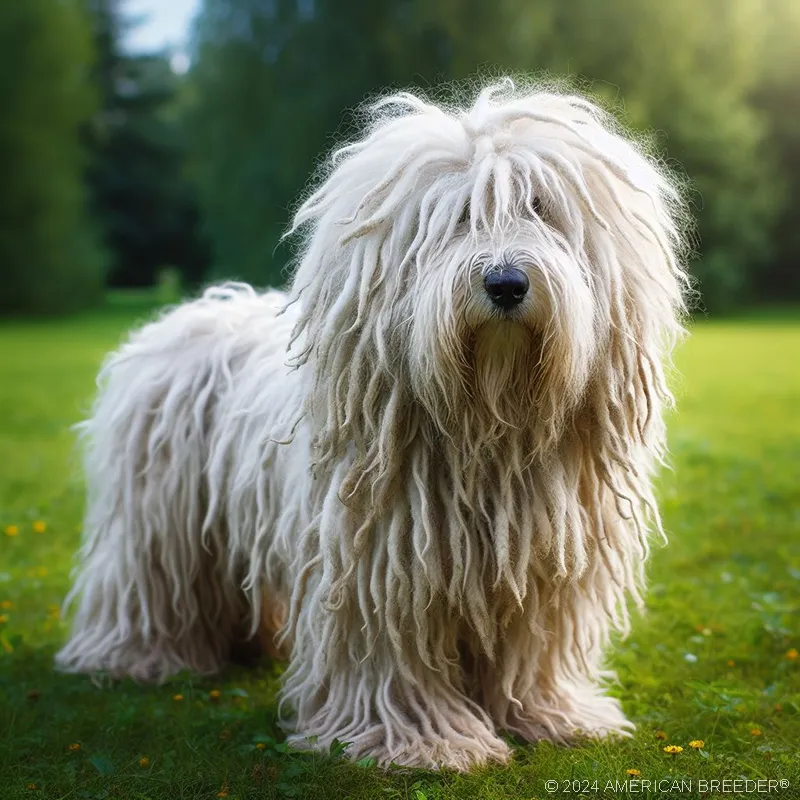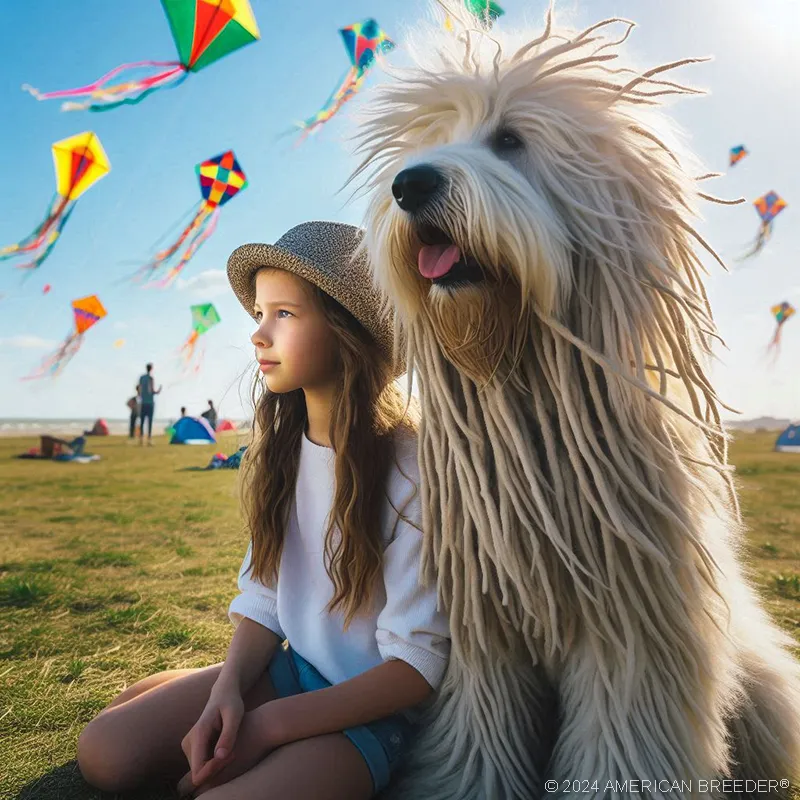Unveiling the Komondor Dog: A Comprehensive Guide
Introduction to the Komondor Dog
 Welcome to the world of the remarkable Komondor Dog, a breed that embodies history, loyalty, and distinctive charm. With its corded coat and guardian instincts, the Komondor is a unique companion that has captivated dog enthusiasts for centuries. As you embark on this journey of discovery, prepare to unveil the breed's attributes, history, care needs, and more.
Welcome to the world of the remarkable Komondor Dog, a breed that embodies history, loyalty, and distinctive charm. With its corded coat and guardian instincts, the Komondor is a unique companion that has captivated dog enthusiasts for centuries. As you embark on this journey of discovery, prepare to unveil the breed's attributes, history, care needs, and more.
Understanding the Komondor's Origins
The Komondor's origins trace back to Hungary, where its guarding prowess protected livestock from predators for centuries. Immersed in Hungarian culture, this breed earned its nickname "mop dog" due to its corded coat's resemblance to mop heads. The breed's historical significance is deeply tied to its role in preserving livestock and property. The Komondor's presence was vital to Hungarian shepherds, offering protection against wolves and other threats, earning it a place of honor in the nation's heritage.
Unraveling the Komondor's Purpose
The Komondor's original purpose as a guardian is etched into its DNA. Bred to be an independent thinker, this breed excels in protecting its charges with minimal human intervention. The deep-rooted loyalty and protective instincts of the Komondor make it a natural guardian, fostering a profound bond with its family. Today, while its guarding role persists, the Komondor also thrives as a loving and devoted family member, balancing its protective nature with affection and companionship.
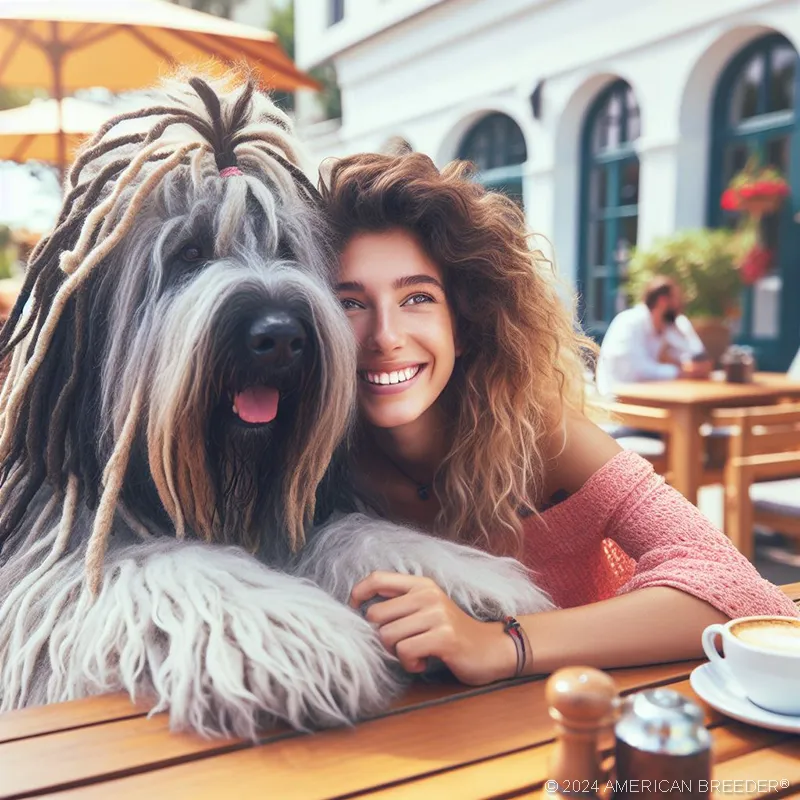 Navigating the World of Coat and Colors
Navigating the World of Coat and Colors
The Komondor's appearance is unforgettable, characterized by its corded coat that evolves as the dog matures. These cords form naturally over time, creating a striking visual. While traditionally known for its white coat, variations such as cream and even rare black Komondors exist. These colors, coupled with the distinctive cords, contribute to the breed's allure. Grooming this coat requires patience and dedication, yet the bond forged during grooming sessions enhances the human-canine connection.
The Komondor's Temperament Unveiled
The Komondor's temperament is marked by its loyalty, independence, and watchful nature. Its protective instincts extend to its family, making it an excellent guardian of children and other pets. This breed's energy levels are moderate, and while it isn't overly exuberant, it is agile and ready for action when needed. The Komondor's dedication to its family fosters a strong bond, creating a steadfast companion that thrives on mutual trust and affection.
Embarking on the Komondor's Care Journey
Health and Well-Being
The Komondor's robust health is attributed to centuries of natural selection and adaptation. While generally healthy, it's important to understand potential health issues such as hip dysplasia, bloat, and eye problems. Regular vet check-ups and preventive measures, including vaccinations and a balanced diet, are essential to maintaining your Komondor's well-being. Embrace the role of a vigilant owner, recognizing signs of discomfort and seeking prompt veterinary attention to ensure a long and happy life for your companion.
Grooming a Komondor requires commitment and patience, but the result is a unique and visually striking appearance. As cords form naturally, this breed's coat provides insulation and protection against the elements. Regular brushing and bathing prevent matting and maintain coat health. While the grooming process may seem daunting, it's a rewarding activity that deepens the bond between you and your Komondor.
Exercise and Mental Stimulation
The Komondor's exercise needs stem from its history as a working guardian. Engage your dog with daily walks, playtime, and mental stimulation games that challenge its agile mind. Consider involving your Komondor in dog sports that tap into its instincts, such as agility and obedience. By catering to its need for both physical and mental activity, you provide a balanced and fulfilling lifestyle that ensures a contented companion.
Nutrition and Dietary Considerations
A well-balanced diet is a cornerstone of your Komondor's health. Consult your veterinarian to determine the best nutritional plan, considering factors like age, activity level, and any allergies. Portion control is vital to avoid
obesity, which can strain joints and impact overall health. High-quality dog food, regular feeding schedules, and occasional treats create a nourishing regimen that supports your Komondor's vitality.
Fostering Socialization and Harmony
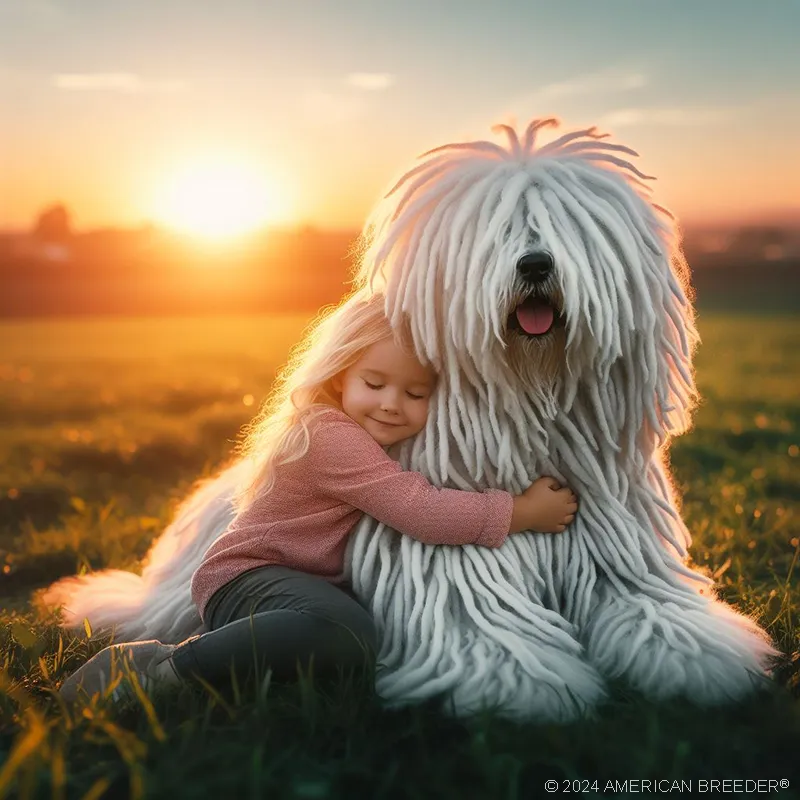 Interaction with Children, Pets, and Strangers
Interaction with Children, Pets, and Strangers
The Komondor's loyal and protective nature extends to its interactions with children, other pets, and strangers. Early socialization is crucial to instill positive behaviors and ensure a well-adjusted companion. With proper introductions and training, your Komondor can thrive in various social settings, embodying its role as a devoted family member.
Multi-Dog Households and Training Ease
Introducing a Komondor to a multi-dog household requires patience and gradual integration. The breed's protective instincts can influence its behavior with other dogs, making socialization and training paramount. Leverage positive reinforcement techniques and consistency to help your Komondor coexist harmoniously with other pets, nurturing its potential for companionship.
Playtime and Shared Activities
Komondors delight in shared activities with their families, solidifying the bonds that define their roles as guardians and companions. Engaging in outdoor adventures, games, and interactive playtime not only meets their exercise needs but also strengthens the human-canine connection. Embrace the joy of shared moments that create memories lasting a lifetime.
Navigating Living Arrangements
 Suitable Environments and Spaces
Suitable Environments and Spaces
The Komondor's adaptability makes it well-suited for various living arrangements, from urban apartments to spacious rural settings. Prioritize space and exercise opportunities to accommodate its moderate energy levels and guarding instincts. Whether you reside in a bustling city or a quiet countryside, creating an environment that fosters both physical and mental well-being is essential for your Komondor's happiness.
Yard Requirements and Climate Considerations
For those with access to outdoor spaces, a secure yard provides the ideal arena for your Komondor to stretch its legs and guard its territory. Adequate fencing is necessary to prevent escape attempts, as this breed's protective instincts can lead it to patrol boundaries diligently. Moreover, consider the climate of your region; while the Komondor's coat offers insulation, providing shade and fresh water during hot weather is crucial to prevent overheating.
Training and Education
Intellectual Engagement and Obedience
The Komondor's intelligence, coupled with its independent nature, necessitates engaging training methods that respect its autonomy. Positive reinforcement and consistency are key to instilling obedience and desirable behaviors. Early training, involving commands like sit, stay, and recall, establishes a foundation for lifelong learning and respectful interactions.
 Advanced Training and Work Roles
Advanced Training and Work Roles
Beyond basic obedience, the Komondor thrives in advanced training roles such as therapy work, search and rescue, and even herding. Leveraging its natural instincts, you can tap into its potential to contribute positively to various roles that showcase its unique abilities. Training in specialized areas not only keeps your Komondor mentally stimulated but also underscores the breed's versatility and intelligence.
Addressing Behavioral Challenges
The Komondor's guarding instincts, while valuable, can manifest as excessive protectiveness if not properly managed. Addressing potential challenges such as territorial behavior and over-guarding requires a balanced approach. Early socialization, consistent training, and setting clear boundaries help your Komondor distinguish between genuine threats and normal situations.
Exploring Health and Longevity
Health Concerns and Preventive Care
While the Komondor is generally a healthy breed, certain health issues should be on your radar. Regular veterinary check-ups, vaccinations, and preventive measures like heartworm and flea prevention are essential. Stay attuned to your Komondor's behavior and habits, as early detection of potential health concerns ensures prompt intervention and a longer, happier life.
Nutrition and Feeding Guidelines
Optimal nutrition is pivotal to your Komondor's overall health and longevity. Consult your veterinarian to tailor a diet that matches its age, size, and activity level. Monitoring portion sizes and avoiding overfeeding is crucial to prevent obesity, a condition that can lead to various health issues. By providing a balanced diet rich in nutrients, you contribute to your Komondor's well-being and vitality.
Regular exercise is vital to maintaining your Komondor's physical and mental health. Engage in activities that cater to its natural instincts, such as interactive play sessions, obedience training, and even dog sports. Satisfying its need for exercise not only keeps obesity at bay but also enhances its overall well-being, ensuring a contented and vibrant companion.
Ethical Responsibility and Ownership
Adopting and Rescuing Komondors
Rescuing a Komondor from shelters or breed-specific rescues is a commendable choice that offers a second chance to a deserving dog. Consider the needs and requirements of adopting a dog with a history, providing a loving environment that nurtures trust and healing. Your compassionate choice contributes to reducing the number of dogs in need of homes.
Supporting Responsible Breeding Practices
If opting for a breeder, prioritize those who adhere to ethical breeding practices that prioritize the breed's health and well-being. Reputable breeders conduct health testing, provide proper socialization, and prioritize the overall welfare of their dogs. Supporting responsible breeders ensures a healthy start for your new Komondor puppy and promotes ethical practices within the breeding community.
Responsible Ownership and Long-Term Commitment
 Owning a Komondor is a long-term commitment that demands dedication, time, and resources. Providing a nurturing home, regular exercise, training, and companionship are essential to fostering a strong bond with your loyal companion. As your Komondor grows and matures, your unwavering commitment ensures a fulfilling and rewarding partnership that enriches both your lives.
Owning a Komondor is a long-term commitment that demands dedication, time, and resources. Providing a nurturing home, regular exercise, training, and companionship are essential to fostering a strong bond with your loyal companion. As your Komondor grows and matures, your unwavering commitment ensures a fulfilling and rewarding partnership that enriches both your lives.
Legal Obligations and Compliance
Complying with Local Regulations
As a responsible dog owner, it's crucial to be aware of local regulations pertaining to dog ownership. This includes licensing requirements, leash laws, and other legal obligations that vary based on your location. Adhering to these regulations not only upholds civic responsibility but also ensures the safety and well-being of your Komondor and the community at large.
Ensuring Your Dog's Safety
In addition to legal obligations, prioritize safety measures that prevent your Komondor from being a nuisance or a danger to others. Leash training, proper containment, and appropriate socialization contribute to a well-behaved and well-adjusted dog that is a positive presence within your community. By being a responsible owner, you create a harmonious environment for both your Komondor and your neighbors.
Resources and Further Learning
Accessing Local Services
 Leverage local resources such as veterinarians, trainers, and grooming services that specialize in working with Komondors. These professionals possess the expertise to address breed-specific needs, ensuring your dog's health, training, and grooming requirements are met with the utmost care and knowledge.
Leverage local resources such as veterinarians, trainers, and grooming services that specialize in working with Komondors. These professionals possess the expertise to address breed-specific needs, ensuring your dog's health, training, and grooming requirements are met with the utmost care and knowledge.
Online Communities and Educational Sources
Engage with online communities and forums dedicated to Komondors, where fellow enthusiasts and owners share experiences, insights, and advice. Additionally, explore reputable websites, books, and articles that offer valuable information about the breed's history, care, training, and more. As you delve deeper into your journey with your Komondor, these resources provide ongoing support and guidance.
Pursuing Ongoing Education
Embrace a continuous learning journey as a Komondor owner by staying informed about the latest advancements in health care, training techniques, and behavioral insights. Attend seminars, workshops, and conferences that focus on canine well-being and behavior. This commitment to ongoing education ensures that you provide the best possible care for your Komondor throughout its life.
Unveiling the Komondor's Allure
Capturing the Essence in Summary
As you reflect on this comprehensive guide, the essence of the Komondor Dog becomes clear—a loyal guardian, a devoted companion, and a breed with a rich history intertwined with human culture. This summary serves as a quick reference for the multifaceted aspects of the breed, inviting you to delve deeper into its world.
Endearing Facts and Unique Traits
Beyond the fundamental information, discover the endearing quirks and unique traits that define the Komondor. From its affectionate nature to its natural guarding instincts, these facets contribute to the breed's distinctiveness and appeal. Exploring these nuances enhances your appreciation for the Komondor's multifaceted personality.
Embracing the Komondor's Distinctiveness
 With an enriched understanding of the Komondor's characteristics, history, and care needs, you're poised to embrace the journey ahead. From puppyhood to adulthood, your Komondor will accompany you through life's adventures, offering unwavering loyalty, protection, and companionship. Its distinctive appearance, coupled with its remarkable personality, ensures that your life will be forever enriched by the presence of this exceptional breed.
With an enriched understanding of the Komondor's characteristics, history, and care needs, you're poised to embrace the journey ahead. From puppyhood to adulthood, your Komondor will accompany you through life's adventures, offering unwavering loyalty, protection, and companionship. Its distinctive appearance, coupled with its remarkable personality, ensures that your life will be forever enriched by the presence of this exceptional breed.
Embracing the Journey
Summarizing Key Insights
As you conclude this comprehensive guide, reflect on the journey you've undertaken to understand the Komondor Dog. From its historical significance to its contemporary role as a beloved family member, you've gained insights into the breed's nature, care requirements, and more. Armed with this knowledge, you're equipped to provide the best possible life for your Komondor.
Continuing Your Learning Path
The world of the Komondor is rich and multifaceted, offering ongoing opportunities for learning, growth, and enrichment. Whether you're a novice owner or a seasoned enthusiast, the journey of discovery never truly ends. As you continue to deepen your understanding and strengthen your bond with your Komondor, remember that there's always more to explore and learn.
Nurturing a Lifelong Bond
Embrace the privilege of sharing your life with a Komondor—a loyal guardian, a steadfast friend, and a source of boundless joy. Through the highs and lows, the triumphs and challenges, your commitment to responsible ownership ensures that your Komondor thrives in a loving and nurturing environment. As you embark on this shared journey, cherish the moments, create lasting memories, and relish in the profound connection you've formed with this extraordinary breed.
 And so, with this comprehensive guide, we've embarked on a journey through the world of the Komondor Dog. From its historical origins to its contemporary role as a devoted companion, we've explored every facet of this breed's existence. As you continue your own journey with your beloved Komondor, remember that this guide serves as a trusted companion, offering insights, knowledge, and inspiration to enrich your bond and ensure the best possible life for your loyal and loving companion.
And so, with this comprehensive guide, we've embarked on a journey through the world of the Komondor Dog. From its historical origins to its contemporary role as a devoted companion, we've explored every facet of this breed's existence. As you continue your own journey with your beloved Komondor, remember that this guide serves as a trusted companion, offering insights, knowledge, and inspiration to enrich your bond and ensure the best possible life for your loyal and loving companion.
A Heartfelt Conclusion
A Tale of Friendship
As we bid farewell to this comprehensive guide, we can't help but reflect on the extraordinary journey we've undertaken together—a journey into the world of the Komondor Dog. Through the pages of this guide, we've delved into the breed's history, examined its unique traits, and uncovered the keys to its well-being and happiness. Yet, beyond the information and insights, what truly matters is the profound bond that you will cultivate with your own Komondor.
A Lifetime of Memories
From the first moment you met your Komondor, a chapter of shared experiences, unforgettable memories, and unwavering companionship began. Whether it's the sight of its distinctive coat, the sound of its devoted barks, or the warmth of its presence by your side, the Komondor has left an indelible mark on your heart. As the years unfold, the pages of your story together will be filled with adventures, challenges, and countless moments of pure joy.
A Future of Possibilities
As you embrace the role of a Komondor owner, remember that you're not only shaping the life of your furry friend but also contributing to the legacy of a remarkable breed. Your dedication to responsible ownership, compassionate care, and endless love paves the way for a future where Komondors continue to thrive as cherished companions and guardians. The journey you've embarked upon is not just a singular chapter—it's an ongoing narrative of growth, learning, and the profound bond between human and dog.
With heartfelt gratitude for joining us on this captivating journey, we've explored the world of the Komondor Dog from its roots to its modern-day significance. As you navigate the rewarding path of being a Komondor owner, may this guide remain a source of guidance, inspiration, and companionship. Cherish the moments, honor the legacy, and relish in the extraordinary connection that defines the relationship between you and your Komondor. Your journey has just begun, and with the unwavering loyalty of your Komondor by your side, every chapter promises to be an adventure of a lifetime.
Komondor Dog Quick Reference Guide
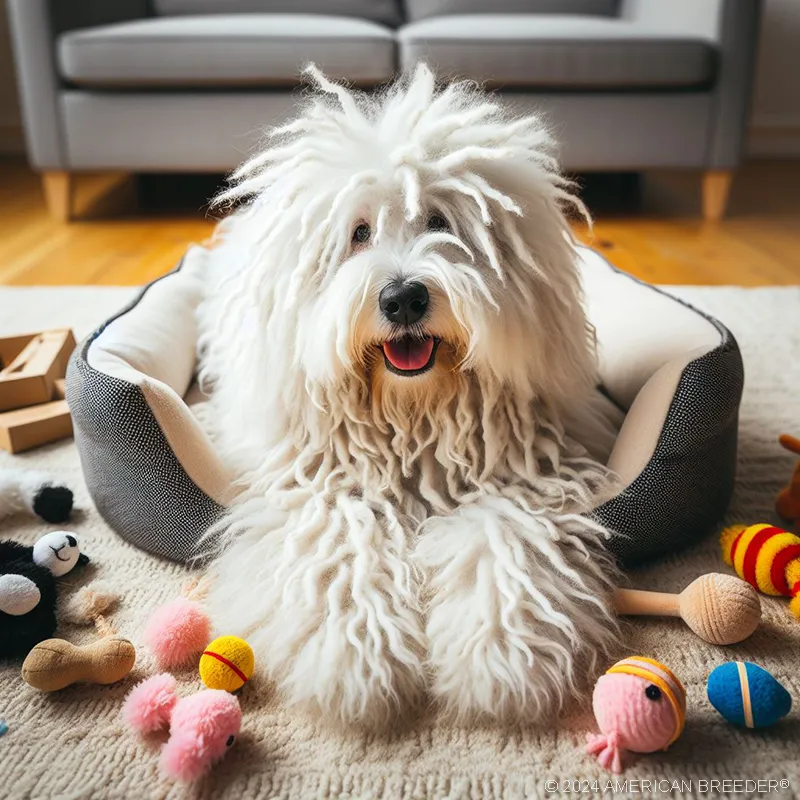 Breed Background: Origin: Hungary | Breed Purpose: Livestock guardian | AKC Class: Working | Year Recognized by AKC: 1937
Breed Background: Origin: Hungary | Breed Purpose: Livestock guardian | AKC Class: Working | Year Recognized by AKC: 1937
Appearance: Size: Large | Weight: 80-100 lbs | Coat Type: Corded | Colors & Patterns: White | Distinctive Features: Corded coat
Temperament: Energy Level: 3/5 | Loyalty: 5/5 | Friendliness to Pets: 3/5 | Friendliness to Strangers: 2/5 | Trainability: 3/5 | Playfulness: 2/5 | Frequent Barker: 3/5 | Chase Instincts: 2/5 | Sense of Smell: 3/5 | Drive to Hunt: 2/5
Health & Care: Health Issues: Hip dysplasia, bloat | Lifespan: 10-12 years | Grooming Difficulty: High | Exercise Needs: Moderate
Socialization: Interaction with Children: Cautious, protective | Interaction with Pets: Moderate tolerance | Interaction with Strangers: Reserved | Elderly Compatibility: Watchful | Ease of Training: Moderate
Suitable Living Arrangements: Apartment: No | House: Yes | Rural Area: Preferred | Yard Size Requirements: Large yard
Training & Obedience: Trainability: 4/5 | Intelligence: 4/5 | Obedience: 3/5 | Problem-Solving: 3/5 | Easily Stimulated: 2/5 | Focus Level: 4/5 | Easily Distracted: 2/5
Financial Planning: Typical Price Range: $1000 - $4000 | Initial Expenses: Puppy basics, training | Ongoing Annual Expenses: Food, grooming
Breeding: Reproductive Maturity: 18-24 months | Litter Frequency: 1-2 litters per year | Litter Size: 6-10 puppies | Stud Cost: Varies | Breeding Challenges: Careful pairing needed
Did You Enjoy this Article? Share it and Help Us Spread the Word!
If you found this article helpful, we'd appreciate it if you could share it with your friends or link to it from your website, blog, or group! You can also use the convenient social share tabs on the left side of the screen to instantly share this page to your social media feed. For more ways to support and promote the American Breeder Community, visit our Share & Promote Together page for social media posts and memes you can copy and share. Your support means the world to us!
Disclaimer: The information provided in this article is for general informational purposes only and does not constitute legal, medical, financial, or professional advice. While we strive for accuracy, we make no representations or warranties regarding the completeness, accuracy, reliability, or suitability of the information. Please consult with a professional before making decisions based on the content provided. American Breeder Inc. assumes no responsibility for any errors or omissions or for the results obtained from the use of this information.

